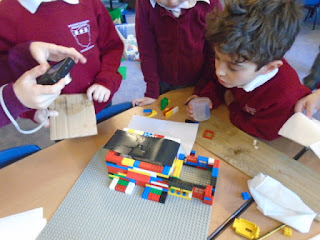In their groups, they had 4 materials - wood, fabric, plastic and cardboard. Their challenge was to come up with an investigation to work out how to test the strength of the materials and also whether they were waterproof. The children made their house walls from Lego - the tricky bit was working out how to actually test the materials. After a lot of discussion and planning, some ideas started to come forward. One group decided to pour water over the materials to check and see how waterproof they were. Another group realised that to make it a fair test, they needed to use an equal amount of water to pour over each material. The children used the cameras and took photos of their investigations.
After the investigation, they concluded that the wood and the plastic were waterproof but after further discussion realised that the plastic would not be rigid enough for the roof.
After their investigation had been completed, the children also discussed and tested how waterproof a brick and some slate are to understand why they are actually good materials for making a roof and wall of most houses.
Working as a team to design the house walls.
Testing with a wooden roof.
Using a plastic roof was not strong enough although it was waterproof.
Pouring the water on the roof of the house to test how waterproof the plastic was.
Holding the fabric in place after it had the water poured on it.
The children concluded that fabric and cardboard were not suitable at all as they were not waterproof, strong or rigid enough. The plastic, although being waterproof, was not strong enough and so they would use a wooden roof.
The discussion and problem solving was brilliant with lots of questions and queries throughout the investigation. Well done Class LH on great teamwork and finding an answer to your hypothesis.





